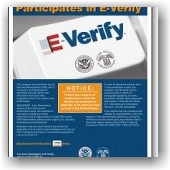DHS finalized a regulation that provides greater flexibility for employers to electronically sign and store I-9 forms, which are used by U.S. Immigration and Customs Enforcement (ICE) to verify employment eligibility-eliminating the need for paper filing and streamlining efforts to ensure a legal workforce nationwide.
Employers—who complete and retain the Form I-9 (Employment Eligibility Verification)—may sign the form electronically and retain the form in an electronic format.
More in the final rule:
1) DHS will allow competing paper and electronic systems: This clarifies that an employer moving to an electronic system need not create digital images/data related to historical paper forms. However, from some employer’s perspective monitoring two distinct verification systems for compliance may be too difficult a logistical challenge. These particular employers have elected to go entirely electronic to take advantage of the ability to monitor compliance and provide for electronic reminders. We strongly recommend that employers should continue to approach converting paper I-9s to electronic images very carefully, first discussing the benefits as well as the concerns (in particular audit related and privilege issues) with their immigration attorneys.
2) The final rule reaffirms that employers will not be required to use a specific technology to complete and store I-9 information, so long as the system they use ensures accessibility and they are able to produce a reasonable facsimile or copy of the I-9.
3) The final rule will also relax the audit trail requirement from the interim rule so that employers no longer have to keep records of when the information is accessed or viewed. Instead, an audit trail will only need to include information on the the initial completion and any subsequent modification to the I-9.
4) The final rule will also relax the interim rule’s requirement to provide a transaction record to the employee at the time the electronic I-9 is created. Under the rule to be published tomorrow, the employer may “provide or transmit a confirmation of the transaction only if an employee requests it . . . within a reasonable period of time.” Finally, the final rule will remove the mandate that the electronic storage system be searchable “by any data element,” requiring only an indexing system that “permits the identification and retrieval for viewing or reproducing of relevant documents and records maintained in an electronic storage system.”
5) Indexing does not require all fields: The final rule identifies that not all of the “data element(s)” must be searchable, but that the system must provide a sense of “searchability” consistent with the amended 8 CFR Sec. 274a.2(e)(6).
More information about I-9 forms and Employment Eligibility Verification is available on the U.S. Citizenship and Immigration Services website at www.uscis.gov/I-9.
For further guidance on the electronic signing and storage of the I-9, and the changes to the current regulations to assist businesses in complying with the requirements of the law, please visit www.ice.gov or view the Federal Register at www.gpoaccess.gov.
::::::::::::::::::::::::::::::::::::::::::
What can Immigration Solution do for you?
Our firm’s years of experience and knowledge with employer compliance and worksite enforcement issues can assist your business in offsetting the extent of sanctions and other ICE enforcement threats. Because of this, employer compliance is becoming more complex and enforcement (investigations and audits) is increasing.
In order to effectively deal with these issues and avoid the very severe consequences for non-compliance, employers must take the time to develop a strategy and be prepared in advance with an Immigration Compliance Program. Immigration Solutions has created a package of services and solutions to assist you with your compliance procedures that can be tailored to your specific needs and concerns. Contact our office should you wish to discuss your audit, training and compliance needs.


